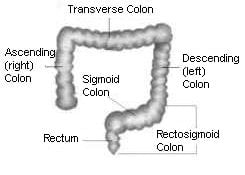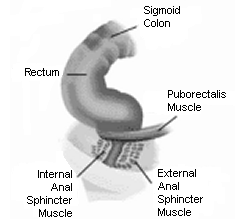The colon is a muscular organ, which is supplied by nerves originating both within and external to the surface that can absorb more than 90% of the fluid which enters it. In normal individuals, approximately 3 to 4 pints of fluid – representing bile, digestive juices, and ingested food – enters the colon from the small intestine each day. The colon is able to reabsorb the majority of this fluid, reducing the water content of the stool to about one-tenth this amount.

A change from liquid to semisolid occurs in the right and transverse portions of the colon. Although undigested food takes less than two hours to reach the colon, it may take as long as 2 to 5 days for it to be expelled as stool. This prolonged transit time is an important aspect of colonic function as it permits more time for water reabsorption to occur.
The descending colon serves as a conduit through which stool is transferred to the rectosigmoid. The rectosigmoid serves as a storage area where stool water is further recovered through absorption. Contraction and emptying of the descending colon and rectosigmoid is stimulated by eating. In the rectum, the pelvic floor muscles (levator ani, puborectalis) regulate fecal retention and defecation. The puborectalis suspends the rectosigmoid and imposes constraints which facilitate voluntary stool retention (continence). Continence is also promoted by contraction of the internal and external anal sphincters.

The urge to defecate is signaled by the propulsion of feces from the sigmoid colon to rectum. Distention of the rectum causes relaxation of the internal anal sphincter. For defecation to proceed, the external anal sphincter and puborectalis must voluntarily relax. The pelvic floor muscles descend, permitting straightening of the anus and rectum. Defecation is facilitated by squatting or sitting and by increasing intra-abdominal pressure.
The process of defecation is learned early in childhood and retains spontaneity throughout life in most persons. The spontaneity of this process may be lost for a variety of reasons, for example due to trauma that occurs from childbirth or other reasons.
When puborectalis or external anal sphincter relaxation is incomplete, functional obstruction (pelvic floor dyssynergia, also referred to as anismus) may occur. Irregularities in muscular relaxation may be congenital (e.g., Hirschsprung’s disease, a rare disorder). Congenital diseases are most often diagnosed in childhood. Hirschsprung’s disease does occur in adults.
Nerves and muscles regulate the transit time of the colon. Derangements in either element may seriously disturb colonic function. When colonic transit time is prolonged (colonic inertia), excess fecal water reabsorption and fecal retention may occur. A number of diseases, such as diabetes or scleroderma, can impair the neural elements of the colon, resulting in severe constipation.
Adapted from IFFGD Publication: Chronic Constipation: From Evaluation to Treatment by Robert D. Madoff, MD, FACS, Division of Colon and Rectal Surgery, University of Minnesota, Minneapolis, MN.








